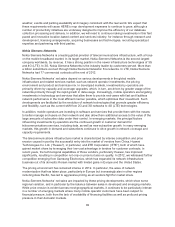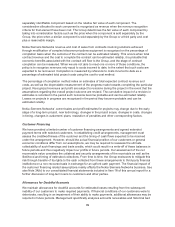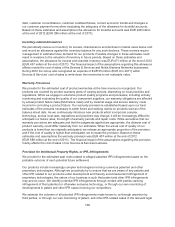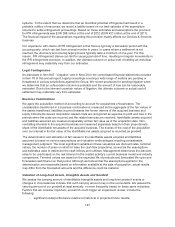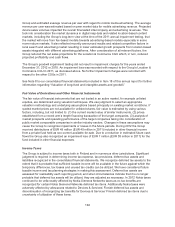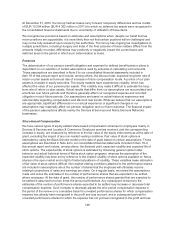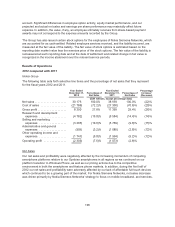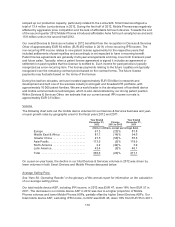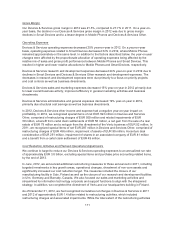Nokia 2012 Annual Report Download - page 103
Download and view the complete annual report
Please find page 103 of the 2012 Nokia annual report below. You can navigate through the pages in the report by either clicking on the pages listed below, or by using the keyword search tool below to find specific information within the annual report.• significant changes in the manner of our use of these assets or the strategy for our overall
business; and
• significantly negative industry or economic trends.
When we determine that the carrying amount of intangible assets, long-lived assets or goodwill may
not be recoverable based upon the existence of one or more of the above indicators of impairment, we
measure any impairment based on discounted projected cash flows.
This review is based upon our projections of anticipated discounted future cash flows. The most
significant variables in determining cash flows are discount rates, terminal values, the number of years
on which to base the cash flow projections, as well as the assumptions and estimates used to
determine the cash inflows and outflows. Management determines discount rates to be used based on
the risk inherent in the related activity’s current business model and industry comparisons. Terminal
values are based on the expected life of products and forecasted life cycle and forecasted cash flows
over that period. While we believe that our assumptions are appropriate, such amounts estimated
could differ materially from what will actually occur in the future. In assessing goodwill, these
discounted cash flows are prepared at a cash generating unit level. Amounts estimated could differ
materially from what will actually occur in the future.
Goodwill is allocated to the Group’s cash-generating units (CGU) and discounted cash flows are
prepared at CGU level for the purpose of impairment testing. The allocation of goodwill to our CGUs is
made in a manner that is consistent with the level at which management monitors operations and the
CGUs are expected to benefit from the synergies arising from each of our acquisitions. Accordingly,
goodwill has been allocated to the Group’s reportable segments; Smart Devices CGU, Mobile Phones
CGU, Location & Commerce CGU and Nokia Siemens Networks CGU. Goodwill amounting to
EUR 899 million, EUR 530 million, EUR 3 270 million and EUR 183 million was allocated to the Smart
Devices CGU, Mobile Phones CGU, Location & Commerce CGU and Nokia Siemens Networks CGU,
respectively, at the date of the 2012 impairment testing.
In the fourth quarter of 2012, we conducted our annual impairment testing to assess if events or
changes in circumstances indicated that the carrying amount of our goodwill may not be recoverable.
The impairment testing was carried out based on management’s assessment of financial performance
and future strategies in light of current and expected market and economic conditions.
The recoverable amounts for the Smart Devices CGU and the Mobile Phones CGU are based on value
in use calculations. A discounted cash flow calculation was used to estimate the value in use for both
CGUs. Cash flow projections determined by management are based on information available, to reflect
the present value of the future cash flows expected to be derived through the continuing use of the
Smart Devices CGU and the Mobile Phones CGU.
The recoverable amounts for the Location & Commerce CGU and the Nokia Siemens Networks CGU
are based on fair value less costs to sell. A discounted cash flow calculation was used to estimate the
fair value less costs to sell for both CGUs. The cash flow projections employed in the discounted cash
flow calculation have been determined by management based on the information available, to reflect
the amount that an entity could obtain from separate disposal of each of the Location & Commerce
CGU and the Nokia Siemens Networks CGU, in an arm’s length transaction between knowledgeable,
willing parties, after deducting the estimated costs of disposal.
The cash flow projections employed in the value in use and the fair value less costs to sell calculations
are based on detailed financial plans approved by management, covering a three-year planning horizon.
Cash flows in subsequent periods reflect a realistic pattern of slowing growth that declines towards an
estimated terminal growth rate utilized in the terminal period. The terminal growth rate utilized does not
102


